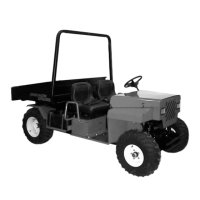SECTION 2 – OPERATING INSTRUCTIONS
WARNING
BEFORE BACKING, Stop machine completely.
LOOK and SEE behind and down for children, pets
and hazards, before and while backing.
2.4.2. Starting Motion - Reverse
A. Complete pre-start checklist.
B. Operator must be seated with seat belt
securely latched and adjusted to a snug fit.
C. Park brake must be set and the transmission in
Neutral.
D. Start engine and allow 2 minute warm up
period.
E. Shift transmission to Reverse. ENGINE MUST
BE AT IDLE SPEED.
F. Release park brake.
G. Back slowly. Move accelerator pedal slowly
and with caution. Do not back at high speeds and
avoid sudden or sharp turns while backing.
H. When changing directions from Forward to
Reverse bring machine to a complete stop first.
Release accelerator pedal and apply brake.
I. Shift transmission to Reverse. Release brake
pedal and back slowly.
2.4.3. Stopping Motion
A. Release accelerator pedal
B. Apply a firm steady pressure to brake pedal,
bringing machine to a controlled stop.
C. Set park brake.
D. Shift transmission to Neutral.
E. Stop engine.
F. Remove key.
2.4 PARKING MACHINE
The park brake has a ratcheting lock mechanism.
When setting the brake a clicking sound will be heard
as the mechanism engages and locks the brake. To
set and hold the machine properly, two or more clicks
may be required. Always park the machine on a flat
surface. Inspect brakes for proper operation before
each use. Refer to Maintenance section of this manual
for inspection and adjustment procedures.
WARNING
DO NOT park machine on slopes. DO NOT leave
machine with engine running. Stop machine. Stop
engine. Set park brake. Shift transmission to
Neutral and remove key before leaving the machine
for any reason.
A. Bring machine to a complete stop on a flat
surface.
B. Move the park brake lever towards the rear of
the slot and latch in the “Locked” position.
C. Depress brake pedal firmly.
D. Stop engine.
E. Shift transmission to Neutral.
F. Remove key.
2.5 USING DIFFERENTIAL LOCK
The differential lock is only used when increased
traction is needed. Locking the differential causes both
rear wheels to turn equally, improving traction. The
differential lock should not be used at speeds in excess
of 10 mph. The differential will remained locked as long
as the control is in the “locked” position. Be sure to
“Unlock” the differential when increased traction is no
longer needed. Do not attempt to turn machine with the
differential locked. The machine and wheels must be
fully stopped before locking differential.
WARNING
DO NOT lock differential until machine and rear
wheel motion has stopped. DO NOT operate
machine at speeds in excess of 10 mph with the
differential locked. DO NOT turn machine with
differential locked. Unlock differential when
increased traction is not required.
A. Bring machine and wheels to a complete stop.
IMPORTANT! All motion must be stopped before
attempting to lock the differential.
B. Move the differential lock lever to the rear of the
slot and latch in the “Locked” position.
C. Shift transmission to desired direction.
D. Move accelerator pedal slowly. The differential
will lock when the rear wheels turn at slightly
different speeds.
E. Drive the machine only in a straight line and at
a slow speed.
F. When increased traction is no longer needed
the differential must be unlocked. Move differential
lock lever to the “Unlocked” position.
G. Resume normal machine operation.

